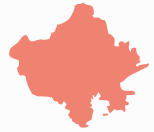world.wikisort.org - India
Bundi District is a district in the state of Rajasthan in western India. The town of Bundi is the district headquarters. It has an area of 5,550 km2 and a population of 1,110,906 (2011 census). It is divided into 5 tehsils which are: Bundi, Hindoli, Nainwa, Keshoraipatan and Indergarh.
This article possibly contains original research. (September 2019) |
Bundi district | |
|---|---|
District of Rajasthan | |
Clockwise from top-left: Garh Palace in Bundi, Keshavrai Temple in Keshoraipatan, Naval Sagar Lake, Waterfall in Bundi district, Doria Dam | |
 Location of Bundi district in Rajasthan | |
| Country | |
| State | Rajasthan |
| Division | Kota |
| Government | |
| • District Magistrate | Renu Jaipal, IAS |
| • MP | Om Birla (Kota) (BJP) |
| • MLA(s) | Ashok Dogra (Bundi) (BJP)
Ashok Chandna (Hindoli) (INC) Chandrakanta Meghwal (Keshoraipatan) (BJP) |
| Area | |
| • Total | 5,550 km2 (2,140 sq mi) |
| Population (2011)[1] | |
| • Total | 1,110,906 |
| • Density | 200/km2 (520/sq mi) |
| Languages | |
| • Official | Hindi |
| • Native | Harauti |
| Time zone | UTC+5:30 (IST) |
| PIN | 323001 |
| Telephone code | 0747 |
| ISO 3166 code | RJ-IN |
| Vehicle registration | RJ-08 |
| Website | bundi |
History
Stone Age tools dating around 5,000 to 200,000 years before present, were found in Bundi and Bhilwara districts of the state.[2] South-east Region of Rajasthan is known as Hadoti - the land of the Hada Rajputs. Hadas are a major branch of the Chauhan Agnikula Rajputs (hailing from fire dynasty). They had settled in the hilly terrain of Mewar, at Bambaoda, near Bijoliya in the 12th century CE. Bundi was established in 1241 CE by Rao Deva Singh. This was the first step in the establishment of Hadauti, when the Hadas moved down from the ‘Pathar’ around Bambaoda. Bundi takes its name from the Bando Naal or the narrow passage, between the rugged hills. The town of Bundi is nestled in the cleft of the Aravalli Range and has a special medieval flavor quite untouched by time. Prince Jait Singh of Bundi captured Kota in 1264 AD and Kota became a part of Bundi as the Jaghir (land grant) of the eldest prince of Bundi. Kota became a separate state in 1624. The state of Jhalawar was formed in 1838 out of Kota territory.
Demographics
According to the 2011 census Bundi district[4] has a population of 1,110,906,[1] roughly equal to the nation of Cyprus[5] or the US state of Rhode Island.[6] This gives it a ranking of 415th in India (out of a total of 640).[1] The district has a population density of 193 inhabitants per square kilometre (500/sq mi) .[1] Its population growth rate over the decade 2001-2011 was 15.7%.[1] Bundi has a sex ratio of 922 females for every 1000 males,[1] and a literacy rate of 62.31%. Scheduled Castes and Scheduled Tribes make up 18.97% and 20.57% of the population respectively.[1]
Languages
Languages of Bundi district (2011)[7]
At the time of the 2011 census, 76.02% of the population spoke Hadauti, 14.35% Hindi, 4.67% Rajasthani and 1.01% Punjabi as their first language.[7]
| Year | Pop. | ±% p.a. |
|---|---|---|
| 1901 | 179,256 | — |
| 1911 | 228,068 | +2.44% |
| 1921 | 196,146 | −1.50% |
| 1931 | 226,482 | +1.45% |
| 1941 | 260,420 | +1.41% |
| 1951 | 292,157 | +1.16% |
| 1961 | 353,267 | +1.92% |
| 1971 | 467,793 | +2.85% |
| 1981 | 612,017 | +2.72% |
| 1991 | 770,248 | +2.33% |
| 2001 | 962,620 | +2.25% |
| 2011 | 1,110,906 | +1.44% |
| source:[8] | ||
See also
- Hadoti
References
- "District Census Handbook 2011 - Bundi" (PDF). Census of India. Registrar General and Census Commissioner of India.
- Pillai, Geetha Sunil (28 February 2017), "Stone age tools dating back 2,00,000 years found in Rajasthan", The Times of India
- "Table C-01 Population By Religion - Rajasthan". census.gov.in. Registrar General and Census Commissioner of India.
- "District Profile". Archived from the original on 1 July 2013. Retrieved 2013-06-20.
- US Directorate of Intelligence. "Country Comparison:Population". Archived from the original on 27 September 2011. Retrieved 1 October 2011.
Cyprus 1,120,489 July 2011 est.
- "2010 Resident Population Data". U. S. Census Bureau. Archived from the original on 1 January 2011. Retrieved 2011-09-30.
Rhode Island 1,052,567
- "Table C-16 Population by Mother Tongue: Rajasthan". censusindia.gov.in. Registrar General and Census Commissioner of India.
- Decadal Variation In Population Since 1901
External links
На других языках
[de] Bundi (Distrikt)
Der Distrikt Bundi (Hindi बूँदी जिला) ist ein Distrikt im westindischen Bundesstaat Rajasthan.- [en] Bundi district
[ru] Бунди (округ)
Бу́нди (англ. Bundi, хинди बूँदी जिला) — округ в индийском штате Раджастхан. Разделён на пять подокругов. Административный центр округа — город Бунди. Согласно всеиндийской переписи 2001 года население округа составляло 962 620 человек. Уровень грамотности взрослого населения составлял 55,57 %, что ниже среднеиндийского уровня (59,5 %). Доля городского населения составляла 18,65 %.Другой контент может иметь иную лицензию. Перед использованием материалов сайта WikiSort.org внимательно изучите правила лицензирования конкретных элементов наполнения сайта.
WikiSort.org - проект по пересортировке и дополнению контента Википедии





